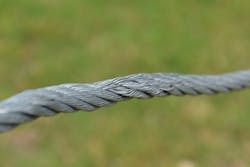University of Extrication: Unraveling the Complexities of Wire Rope
Topic: Understanding wire rope specifications
Objective: Better understand wire rope construction, specifications and safety operating considerations
Task: The rescue team shall grasp how to determine when its winches can and can’t be used based on the condition of their wire rope
Wire rope is the steel cable that can be found on rescue winches and cable come-along tools and that can be used when a Grip-Hoist tool is utilized.
Safe and proper use of wire rope is multifaceted; this column speaks to: the specifications for steel wire rope; how to determine working load limit (WLL); end fittings; and what a visual inspection of wire rope should include.
(Of course, synthetic rope can be used instead of steel cable for pulling tools, and some rescue crews and tow truck operators go that route.)
Construction specs
Wire rope is constructed of many small, individual strands of wire that are twisted together to form several large strands. These larger diameter strands are twisted together into a braid pattern to form the wire rope. The direction that these strands are twisted together is called the “lay” of the wire rope. A right-hand lay is most common. Knowing the lay of the rope allows you to identify physical damage, because the spiral pattern is interrupted.
The number of wires per strand and the number of strands that are twisted together to form the wire rope influence the strength of the wire rope. An industry-standard numbering system speaks to these two numbers. For example, a 6 x 19 wire rope specification indicates that a steel wire rope has at least 19 individual wires that form each strand, and six strands are twisted, or braided, together to form the finished line.
Manufacturers also indicate the grade of steel that’s used to make the wires. Improved plow steel (IPS), extra improved plow steel (EIPS) and extra extra improved plow steel (EEIPS) are the highest grades of wire that are used in making rope. (This is similar to noting the different types of steel that are used to make the various grades of rescue chain.)
In addition to these facets, rescue personnel, particularly those who work with winch units, should be familiar with the wire rope thickness and overall length of the line itself. For example, a rescue crew might have a detachable 9,000-lb.-rated winch that’s equipped with 7/16-inch IPS wire rope of 6 x 19 construction that’s 125 feet in length.
Because the right- or left-hand lay braid pattern of the strands can leave a hollow center core area within the wire rope, the core area might be filled with a material, such as a fiber, a synthetic element or a strand of steel. Center core filler material helps to keep the wire rope together. It also serves as a friction reducer to help the strands of the line slide and adjust at bends and turns during use. Sometimes, when wire rope degrades or is damaged, the filler material emerges from the core.
Discuss your rescue applications with your wire rope supplier, so the best core material can be identified.At the end of the wire rope line, there typically is a hook of some sort that’s attached within an eye. The eye of the wire rope line is the loop, with or without a reinforcing band or thimble, at the end of the rope. The end fitting eye and the hook allow rescuers to attach the wire rope of the winch line to, for example, a chain or a sling that is around the object to be winched. The end-fitting hook can be attached to the wire rope with a common turnback design, where the line is folded and clamped back onto itself. A tapered compression clamp holds the folded line together.
The Flemish eye is another of the numerous ways to create and secure the eye of the line. The Flemish eye has the individual strands separated and woven back together into the line itself where a different style compression clamp is applied.
All this said, the strength rating of a turnback design compared with a Flemish eye or other designs is minimal and less important to rescue personnel than is knowing that the end fitting, when inspected physically, should be clean, firm, tight and without any physical damage.WLL
As an industry-standard, wire rope generally isn’t assigned a WLL but, rather, a published breaking strength. However, the WLL is a load number (in pounds) that isn’t to be exceeded during normal use, so it must be known. It is a calculated number and reflects a 5:1 safety factor. To determine the WLL for wire rope, take the breaking strength number that’s provided by the manufacturer and divide by five.
This safety margin means that if the wire rope has been inspected and found in serviceable condition with no defects, actual failure could occur at five times the WLL number. As an example, if you apply a 5:1 safety factor to wire rope that has a breaking strength of 37,000 lbs., the math results in a WLL of 7,400 lbs.
However, it must be remembered that this 5:1 ratio is based on the breaking strength number that’s determined under laboratory conditions, when the wire rope is new and it’s tested in a straight-line pull. Real-world applications, any unexpected shock loading, the age and condition of the wire rope and previous misuse or abuse of the line might unknowingly reduce this margin. Rescuers should consider that the 5:1 ratio as an absolute safety margin—that failure won’t occur until theoretical maximum load is reached—is somewhat misleading. Determine the WLL for your wire rope and all system components and stay within these WLLs during training as well as real-world applications. When properly used at or below the WLL and when properly maintained, your wire rope rigging system should work as you want it while giving you an acceptable safety margin.Inspection guidelines
During routine equipment checks and prior to the use of any wire rope, the entire length of the wire rope should be inspected, including the eye, end fitting and hook. This isn’t a quick job for a rescue winch unit. It takes effort probably from several rescuers. Proper inspection and record-keeping of wire rope serve to prevent an injury or worse that’s caused by a line failure at an incident scene.
Occupational Safety and Health Administration standard 1926.1413 provides guidance for wire rope inspection. Your rescue crew or department will need to have a “designated” person and a “qualified” person involved in the inspection process. Essentially, with all of the line extended out from the winch drum and visible, rescuers (hands gloved, eye protection on) look and feel for apparent visual or physical deficiencies.
Deficiencies can include lumps, distortion or stretching of the line, kinks, visible broken strands or wires, crushed/flat spots with diameter reduction, areas where strands no longer are twisted properly (called unstranding), signs of core failure or protrusion, loose end fittings and other damage, such as corrosion or heat damage.
Any damage should condemn the entire length to out-of-service status and require suitable replacement. If in doubt, take the tool and the wire rope out of service.
Wire Rope Specs
Diameter of wire rope
Number of strands x wires/strand
Type of steel
Length of wire rope
Breaking strength and WLL at 5:1 (example: 7/16 inches, 6 x 19 EIPS, 125 feet in length, WLL of 7,400 lbs.)
About the Author
Ron Moore
RON MOORE, who is a Firehouse contributing editor, recently retired as a division chief with the McKinney, TX, Fire Department and now serves with Prosper, TX, Fire Rescue. He self-published the Vehicle Rescue 1-2-3 training manual and serves as the forum moderator for the extrication section of Firehouse.com . Moore can be contacted directly at [email protected].




